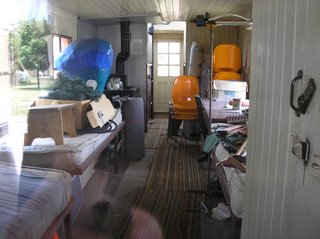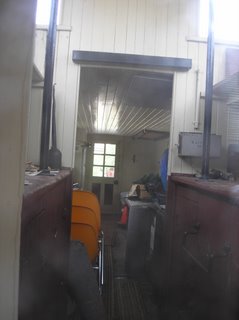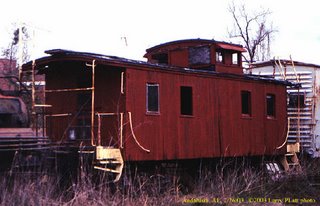Old Wooden Woody

Well, well, look what we have here!
Okay folks, I’ll be taking some time to write about occasions of exploration we had over the summer months, and though late, better than ever to get them all posted for you to see, and me to print off for the continuous journey of eastern living for our family to keep in a book. I intend to get caught up during the upcoming week ahead; if possible, as there are many activities and events we were so excited about to share with you.
Today, I want to share how thrilled hubby was to find a real “Woody” sitting pretty and in fairly good condition while out on one of our journeys. Instead of turning his head towards the fascinating Victorian home on the other side of the street I was pointing to, he glanced and stared almost in disbelief out his own window the other way and didn’t/wouldn’t heed my request. Not knowing something else had captured his full attention, I realized it was huge when gazing towards his sighting, then knew why.

What I was looking at...
He stopped the vehicle, opened the door and within a few short steps, time stood still, when he was quietly walking back in time to when he was a young lad working the rails from dawn to dusk traveling all over the place for days at a time. Did I mention yet this was a pivotal moment when I just knew the camera had to click away?

What hubby saw...
Yes, at the young age of seventeen, this was like a grand hotel to him, and he actually slept in one of these same types of cabooses many days and nights. This particular Woody we realized was purchased by a little town we’d stumbled into on our journey. It had dropped off in an “as is” condition, and hadn’t yet been refurbished back to its original state. All original furnishings, equipment and other items were still in their original places. That was SUPER okay however, as hubby was sent into a thrilling nostalgic time warp, flooded by memories of his youthful days gone by. I will share his words with you below, working my way from picture to picture.
Enjoy!
Like all “Woodys”, this caboose is an original used for fifty or sixty years, built in approximately the 1920’s, until such time as modern technology introduced metal cabooses for use in rail transportation.

Now sitting retired and settled into its grand splendor.
The purpose of a caboose was to have a constant visual inspection from the tail-end of the train, on that portion not visible to the engine. It housed important tools, emergency supplies and equipment for possible derailments or wash outs. It was also considered the conductor’s office on wheels and it represented a formerly required safety aspect of rear end or tail end protection from one train to another, when operating in former train control method called “manual block systems” and/or “train order territory”.
Traditionally the conductor and tail-end brakeman in the caboose were members of a four man crew, which also included the head-end brakeman and the locomotive engineer rode in there. This was a former composition of a train crew prior to the late 1980’s.
 Restoration would be in order, but what a wild ride observing hubby's walk back in time and catching this expression on his face as he just looked into the back window to see all in its original place!
Restoration would be in order, but what a wild ride observing hubby's walk back in time and catching this expression on his face as he just looked into the back window to see all in its original place!
Technology, Union agreements and better methods of train control, now referred to “centralized traffic control” (CTC). This has allowed trains to have electronic train protection and the operating crew consists now of one conductor, one engineer, both on the head end of the locomotive of each train now.
Details;
The caboose included a full block maintained refrigerator system, coal and later oil fueled stoves, sleeping quarters for four, dining table for four, the conductor’s desk or office at each end and a copula up top for the purpose of one or two of the tail-end crew members to make in-train observations, of their assigned train while traveling around curves.

As though it was walked away from and abandoned "as is". Original furnishings and equipment still grace its interior wooden walls.
Crew members were also required to inspect the track behind the caboose for any telltale tie or road bed, and/or track damage that may indicate something wrong or even possible dragging equipment within their own train, or worse, a possible derailed wheel. These wooden cabooses or “Woodys” as we called them in the past, were considered for fifty plus years to be the epitome of safety for trains while they were traveling anywhere in the world.

Another shot featuring the wooden panelled walls and
upgraded carpeting of the early days.
Before bearings, they used to have housing at the end each axle of every wheel of every car, and in that housing there used to be industrial type of “sponge” for the lack of a better word really, which maintained a reservoir of oil for the purpose of keeping each axle lubricated and cool enough to be able to operate over a very long distances without continuous maintenance.

Even the black long nosed oil can was still here!
Notice the long nosed black oil can on the left side of the center aisle in this picture. This oil can was used as a refillable portable device by the brakeman. While working on a trip, if there was any noticeable smoking wheel on a train car while in motion, the train would have to be stopped, and he (the brakeman) would have to walk up to the car in question to oil the wheel, using this exact device. Trains used to be a mere 50 cars in length in those days, so the waltz up to the car on a time limit schedule was no big deal, where as now, they are upwards of 160 cars in length. Interesting the black oil can is still in this very caboose, in its exact location for the train crew to find, unchanged from days gone by! That was a wild nostalgic citing for hubby.

The observation windows where two could sit and do their work.
Cabooses were always known as “the end of the line” on trains. Just ask any child in years gone by when the train was over, and they would tell you “when we see the caboose”, “watch for the red caboose”, or in this case “the wooden caboose”. However with the advance of technology, cabooses became redundant because the tail-end protection was no longer required with the introduction of centralized traffic control signal systems now affording the tail-end protection. The running gear on every train, including the temperature of wheels, dragging equipment, gaze of wheels between axle, and speeds are all monitored by wayside electronic technology that scans every train, every ten or fifteen miles it travels depending on the territory. The last car on each train now carries a device, nicknamed the “hot box detector”.
 End of an era...
End of an era...Just as the industrial revolution fueled on by the great steam locomotives of their day, eventually replaced by new technology of diesel electric locomotives, so too did the caboose find its way into the history books of the same era, due to mankind’s insistent technical revolutions of the day. Cabooses had their place then, and due to the nostalgia of them, just as the old trolley cars or old passenger train cars, many specialty groups have purchased or restored them for the good of that history for future generations to view, learn and appreciate them well. Many trolleys or train cars are now seen in restaurants or museums (Spaghetti factory restaurant, and others), and like their counterparts, “Woodys” have found their place in many museums, public gathering locales and memorial locations (Fort Langley, Chilliwack) throughout the world.

This woody is sitting pretty next to an old train staion,
now converted into a library.
It was a great find this day, a great education for our children too as their father recounted his previous line of work, grasping for a wee naptime while out on the rails on those very similar types of beds, retold stories of life as a brakeman, gave a few incidences of fun and pranks inside the cabooses he was a part of and smiled all day long as we continued our journey.

Speaking of old woody cabooses, please click onto THIS LINK HERE in case you're ever over on Galiano Island in the Pacific, to see it refurbished and now a place to stay. Unreal!
Also, you'll know this caboose above is in fairly good condition, compared to these below...only a few of the many now retired around North America.


 Well, well, look what we have here!
Well, well, look what we have here! Restoration would be in order, but what a wild ride observing hubby's walk back in time and catching this expression on his face as he just looked into the back window to see all in its original place!
Restoration would be in order, but what a wild ride observing hubby's walk back in time and catching this expression on his face as he just looked into the back window to see all in its original place!




.jpg)




















